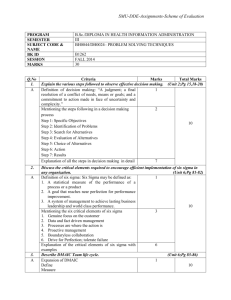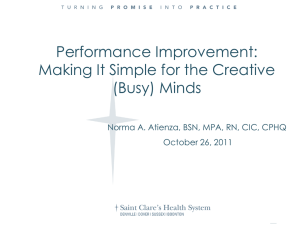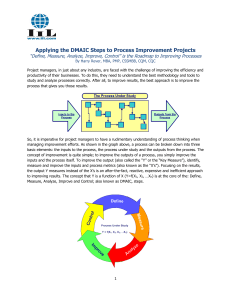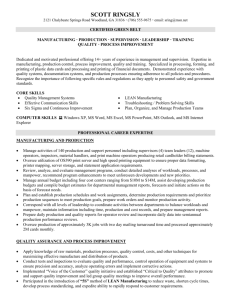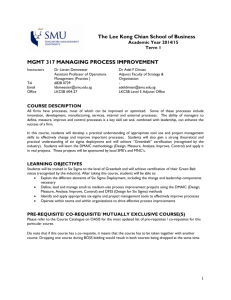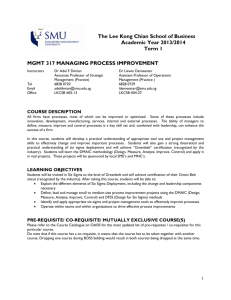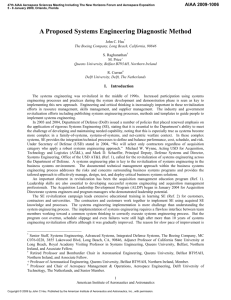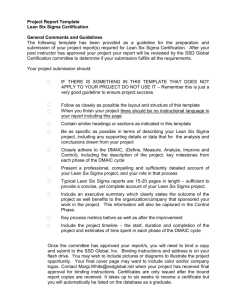Define-Measure-Analyze- Improve
advertisement
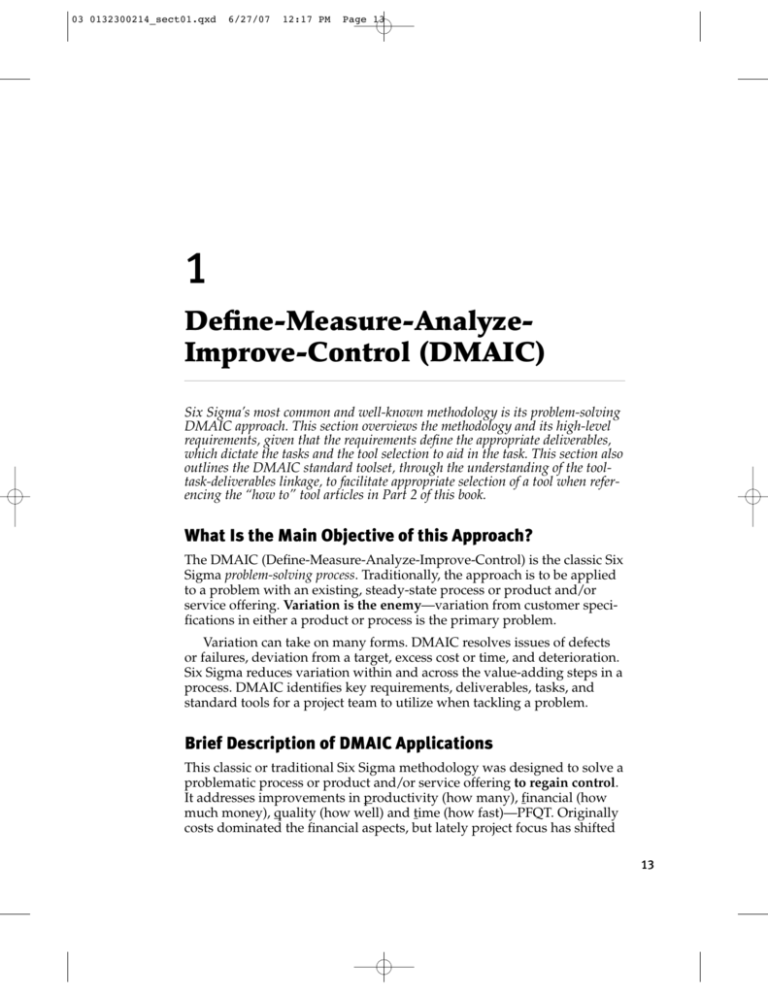
03 0132300214_sect01.qxd 6/27/07 12:17 PM Page 13 1 Define-Measure-AnalyzeImprove-Control (DMAIC) Six Sigma’s most common and well-known methodology is its problem-solving DMAIC approach. This section overviews the methodology and its high-level requirements, given that the requirements define the appropriate deliverables, which dictate the tasks and the tool selection to aid in the task. This section also outlines the DMAIC standard toolset, through the understanding of the tooltask-deliverables linkage, to facilitate appropriate selection of a tool when referencing the “how to” tool articles in Part 2 of this book. What Is the Main Objective of this Approach? The DMAIC (Define-Measure-Analyze-Improve-Control) is the classic Six Sigma problem-solving process. Traditionally, the approach is to be applied to a problem with an existing, steady-state process or product and/or service offering. Variation is the enemy—variation from customer specifications in either a product or process is the primary problem. Variation can take on many forms. DMAIC resolves issues of defects or failures, deviation from a target, excess cost or time, and deterioration. Six Sigma reduces variation within and across the value-adding steps in a process. DMAIC identifies key requirements, deliverables, tasks, and standard tools for a project team to utilize when tackling a problem. Brief Description of DMAIC Applications This classic or traditional Six Sigma methodology was designed to solve a problematic process or product and/or service offering to regain control. It addresses improvements in productivity (how many), financial (how much money), quality (how well) and time (how fast)—PFQT. Originally costs dominated the financial aspects, but lately project focus has shifted 13 03 0132300214_sect01.qxd 14 6/27/07 12:17 PM Page 14 Define-Measure-Analyze-Improve-Control (DMAIC) to revenues and growth. The 5-step DMAIC [pronounced “duh-MAY-ick”] method often is called the process improvement methodology. The classic strategy reduces process variance (in total, across the activities and within-step) to bring it back on target—the customer specification or requirement. Knowing that Six Sigma resolves more issues than just cycle time, Figure 1-1 highlights its impact on cycle time by contrasting a problematic process versus its post-Six Sigma improved state. Step 1 Step 2 Step 3 Step 4 Problematic Process Process After Six Sigma Step 1 Step 2 Step 3 Step 4 Cycle Time Figure 1-1: Six Sigma’s Impact on Cycle Time The DMAIC approach is designed to allow for flexibility and iterativework, if necessary. As more is learned through the 5-step process, assumptions or hypotheses as to the root cause of the problem may be disproved, requiring the project team to revisit them and modify or to explore alternative possibilities. For example, root cause to a sales force effectiveness issue may have been hypothesized as a sales training problem in a specific geographic region. Rather than jumping to conclusions without facts by implementing a new sales training program, the Six Sigma project team wisely decides to gather facts about the problem first. After some investigation and analysis, the team discovers that the root cause points to an issue with sales management direction, not lack of sales representatives’ knowledge and skills. If the project team acted upon the original assumption, time and money would have been wasted on developing a mismatched solution that would have produced poor results; the team’s hard work would have gone to waste. Instead, the team did a mid-course correction based on facts, adjusted its hypothesis, and developed a solution directly aimed at the true root cause—hence favorable results ensued. DMAIC builds on three fundamental principles: • Results-focused; driven by data, facts, and metrics. • Work is project-based (short-term in nature, with length depending on scope and complexity) and project-structured, versus an ongoing process. 03 0132300214_sect01.qxd 6/27/07 12:17 PM Page 15 Brief De scription of DMAIC Applications 15 • Inherent combination of tools-tasks-deliverables linkage that The DMAIC methodology uses a process-step structure. Steps generally are sequential; however, some activities from various steps may occur concurrently or may be iterative. Deliverables for a given step must be completed prior to formal gate review approval. Step Reviews do occur sequentially. The DMAIC five steps are Step 1. DEFINE the problem and scope the work effort of the project team. The description of the problem should include the pain felt by the customer and/or business as well as how long the issue has existed. Hence, identify the customer(s), the project goals, and timeframe for completion. The appropriate types of problems have unlimited scope and scale, from employee problems to issues with the production process or advertising. Regardless of the type of problem, it should be systemic—part of an existing, steady-state process wherein the problem is not a one-time event, but has caused pain for a couple of cycles. Step 2. MEASURE the current process or performance. Identify what data is available and from what source. Develop a plan to gather it. Gather the data and summarize it, telling a story to describe the problem. This usually involves utilization of graphical tools. Step 3. ANALYZE the current performance to isolate the problem. Through analysis (both statistical and qualitatively), begin to formulate and test hypotheses about the root cause of the problem. Step 4. IMPROVE the problem by selecting a solution. Based on the identified root cause(s) in the prior step, directly address the cause with an improvement. Brainstorm potential solutions, prioritize them based on customer requirements, make a selection, and test to see if the solution resolves the problem. Step 5. CONTROL the improved process or product performance to ensure the target(s) are met. Once the solution has resolved the problem, the improvements must be standardized and sustained over time. The standard-operating-procedures may require revision, and a control plan should be put in place to monitor ongoing performance. The project team transitions the standardized improvements and sustaining control plan to the process players and closes out the project. A DMAIC project typically runs for a relatively short duration (three to nine months), versus product development projects (using UAPL or DFSS) and operational line management (using LMAD), which can run DMAIC varies by step in the method. 03 0132300214_sect01.qxd 16 6/27/07 12:17 PM Page 16 Define-Measure-Analyze-Improve-Control (DMAIC) years. Given the relatively shorter duration to other types of Six Sigma methodologies, we distinguish the DMAIC as having five steps, rather than phases. The DMAIC method is primarily based on the application of statistical process control, quality tools, and process capability analysis; it is not a product development methodology. It can be used to help redesign a process—any process, given that the redesign fixes the initial process problem. To be implemented, the method requires four components: • A measurement system (a gauge) of the process or product/service offering in trouble. • Standard toolset that supports tasks to produce deliverables (including statistical, graphical, and qualitative tools and techniques). • An ability to define an adjustment factor(s) to correct the process or product/service offering back on target. • A control scheme to maintain the improvement or correction over time by implementing a control plan with a monitoring system to audit the response performance against statistical control limits and defined action plans if needed. What Key Overall Requirements Define this Approach? Requirements come from the customer and the business, depending on the problem scenario. The (internal and external) customer requirements get translated into what is critical-to-quality (CTQ). These CTQs define the criteria to evaluate what good looks like—how well the project scope and deliverables meet requirements. Hence, the project team must meet the requirements of a phase before declaring completion and closing it out. The DMAIC method was designed and structured to answer the following overall business questions: • What does the customer define as the problem? (Secondarily, is the problem sustained over time, is it chronic, or is it a one-time occurrence?) • What characterizes the current problem (e.g., process and performance metrics), and how has it changed over time? (Secondarily, is the process in control, and does it have a good measurement system? Is the process capable of producing the customer requirements?) 03 0132300214_sect01.qxd 6/27/07 12:17 PM Page 17 What Requirement Determine s the Key Activitie s in this Approach? 17 (Secondarily, is the process capable of producing the customer requirements?) • What controls should be implemented to sustain this improvement, including a warning system, action plan, and communication plan needed in case requirements fail to be met? (Secondarily, can the improvements be sustained over time?) What Requirement Determines the Key Activities in this Approach? The preceding key business questions determine the DMAIC architecture. Figure 1-2 depicts a high-level process flow of the DMAIC method through its five steps. Define Measure Analyze Yes Problem over-time? No Improve No In Control? Yes No Remove Known Special Causes Process Capable? Yes Yes Close Project Close Project Good measurement system? Control Yes No No Process Capable? Sustained Improvement? Yes Close Project No Remove Measurement System variation Figure 1-2: High-Level DMAIC Process Flow Table 1-1 shows the linkage between the high-level business requirements and the five-step DMAIC method. DMAIC • What are the root causes, and what improvement actions correct them to meet customer requirements again? 03 0132300214_sect01.qxd 18 6/27/07 12:17 PM Page 18 Define-Measure-Analyze-Improve-Control (DMAIC) Table 1-1: DMAIC Requirements-Step Linkage Requirements Resulting High Level Task (Step) What does the customer define as the problem? 1. DEFINE • Describe in the words of the external or internal customer—Voice of Customer (VOC). • Define the boundary conditions set forth by the business, including regulatory environment—Voice of Business (VOB). • Understand the current process. What has happened over time, examine process control charts to identify incidents of common and special cause variation— Voice of the Process (VOP). What characterizes the current problem (that is, process and performance metrics), and how has it changed over-time? 2. MEASURE • Measure the problem; describe it with facts, data, and performance metrics. Determine if the process in control and if the measurement system is accurate. • Considered iterative until metrics are gathered over time. What are the root causes? 3. ANALYZE Determine if the process capable of producing the customer requirements. If not, consider it iterative until root causes are identified and verified with facts and data. What improvement actions correct the root causes to meet customer requirements again? 4. IMPROVE Determing if the process is capable of producing the customer requirements. If not, consider it iterative until improvements are identified and verified with facts, data, and performance metrics. What controls should be implemented to sustain this improvement, including a warning system, action plan, and communication plan needed in case requirements fail to be met? 5. CONTROL • Demonstrate how the improvements and/or changes can be sustained. • Manage Risks 6/27/07 12:17 PM Page 19 What Tools Are Aligned to Each Step of the Proce ss? Figure 1-3 provides a DMAIC icon that reinforces both the overall flow of a method and the purpose of each step and respective interrelationships. It summarizes the five-step DMAIC process and its notable iterative nature. Throughout the remainder of this text, Figure 1-3 will symbolize the DMAIC approach and indicate a particular step within it if appropriate. Define Measure Analyze Improve Control Figure 1-3: DMAIC Icon What Tools Are Aligned to Each Step of the Process? Given the preceding High Level Task Step(s), the following series of tables summarize the subsequent tool-task-deliverables combination associated with each individual step within the five-step approach. The detail behind how to use each tool can be found in Part II, “Six Sigma Encyclopedia of Business Tools and Techniques: Choosing the Right Tool to Answer the Right Question at the Right Time.” Table 1-2: Define Tools-Tasks-Deliverables Step 1: DEFINE Define Measure Analyze Improve Control What does the customer define as the problem? Deliverables Tasks Candidate Tools and Techniques Project Charter Approved Identify Problem • SMART (contract with the statement/Opportunity • Project Charter Form Sponsor regarding and Goal statement. containing: Problem problem, project scope, Statement (As-Is), project goal(s), key Desired State (To Be), deliverables, timeframe, and the Business Reasons and budget) • Big “Y” over time continues 19 DMAIC 03 0132300214_sect01.qxd 03 0132300214_sect01.qxd 20 6/27/07 12:17 PM Page 20 Define-Measure-Analyze-Improve-Control (DMAIC) Table 1-2: Continued Deliverables Tasks Candidate Tools and Techniques High-level Process Map Constructed Develop High-level Process Map • Process Map • RACI Matrix Critical Parameters Hypothesized Gather VOC and Business Requirements • VOC/VOB Gathering techniques • Current process control charts (VOP) • Stakeholder Analysis • CTQ Project Charter Published and Communicated Develop Communication Plan Communication Plan template High-Level Project Plan Defined and Approved Finalize Project Charter • Project Charter Form • High-level Process Map • SIPOC • Project RACI Matrix Table 1-3: Measure Tools-Tasks-Deliverables Step 2: MEASURE Define Measure Analyze Improve Control What characterizes the current problem, and how has it changed over time? Deliverables Tasks Candidate Tools and Techniques Data Collected • Identify Sources • of Data • Collect Baseline • Data from existing process • • Determine current • Process Performance; • is it in control? • • Remove any known special causes; verify if process is in control Y = f(X); Big “Y” and little “Ys” Data Gathering Plan template Control Charts Statistical Sampling Graphical Methods QFD (Quality Function Deployment) 6/27/07 12:17 PM Page 21 What Tools Are Aligned to Each Step of the Proce ss? Deliverables Tasks Candidate Tools and Techniques Process Map Defined In-depth With Current Measures Develop Detailed Process Map • Detailed Process Map • RACI Matrix, revised Current Measurement System Capability Evaluated • Validate measurements and collection system • Is the process capable of meeting requirements? • Measurement System Analysis (MSA) • Process Capability Analysis Project Charter and Plan updated, as necessary • Revise Problem and • Project Charter; its plan Goal statements as and milestones needed • Project RACI Matrix • Update Project Plan, as needed Table 1-4: Analyze Tools-Tasks-Deliverables Step 3: ANALYZE Define Measure Analyze Improve Control What are the root causes of the current problem? Deliverables Tasks Candidate Tools and Techniques Data Analyzed • Validate gaps in • requirements vs. current metrics • • Establish Y=f(X) • Quantify Opportunity • to close gaps • Y = f(X); Big “Y”; little “Ys” and the “Xs” Critical Gap/Step Analysis Pareto Charts Statistical Analysis: Normal Distribution, Variation • Correlation and Regression continues 21 DMAIC 03 0132300214_sect01.qxd 03 0132300214_sect01.qxd 22 6/27/07 12:17 PM Page 22 Define-Measure-Analyze-Improve-Control (DMAIC) Table 1-4: Continued Deliverables Tasks Candidate Tools and Techniques Process Analyzed • Develop Detailed • Detailed Process Map Process Map (inputs, outputs, met• Establish Y=f(X) rics, process step • Quantify Opportunity owners) to close gaps • RACI Matrix, revised • Process Mapping of Critical Parameters • Y = f(X) • Pareto Charts • Process Capability Analysis Root Cause Analyzed • Conduct Root Cause Analysis • Prioritize Root Causes • Quantify Opportunity to close gaps Project Charter and Plan updated, as necessary • Revise Problem and • Project Charter; Goal statements as its plan and milestones needed • Project RACI Matrix • Update Project Plan, as needed • Brainstorming Technique • Cause and Effect Diagrams • Five Whys • Affinity Diagram (KJ) • Hypothesis Testing of key causes and/or critical parameters (vital few Xs) • Inferential statistics (Correlation and Regression) • DOE • FMEA 03 0132300214_sect01.qxd 6/27/07 12:17 PM Page 23 What Tools Are Aligned to Each Step of the Proce ss? 23 Table 1-5: Improve Tools-Tasks-Deliverables Define Measure Analyze Improve Control What improvement actions correct the root causes to meet customer requirements again? Deliverables Tasks Candidate Tools and Techniques Potential Solution Generated Develop Potential Improvements or solutions for root causes • Brainstorming Technique • Positive Deviance • TRIZ Potential Solution Evaluated • Develop Evaluation Criteria • Measure results • Evaluate improvements meet targets • Evaluate for Risk • • • • Solution Selected Select and Implement • Pugh Concept improved process and Evaluation metrics • Solution Selection matrix • Force Field diagram • QFD • Measurement System Analysis (MSA) • Process Capability Analysis Improved Path Forward Implemented Develop Detailed Future Process Map of improvement Project Charter and Plan updated, as necessary • Revise Problem and • Project Charter; its plan Goal statements as and milestones needed • Project RACI Matrix • Update Project Plan, as needed Basic DOE Pilots/Tests FMEA Cost/Benefit Analysis • Detailed Process Map • RACI Matrix, future • Procedure manual (standard operating procedure) • Implementation and Transition Plan DMAIC Step 4: IMPROVE 03 0132300214_sect01.qxd 24 6/27/07 12:17 PM Page 24 Define-Measure-Analyze-Improve-Control (DMAIC) Table 1-6: Control Tools-Tasks-Deliverables Step 5: CONTROL Define Measure Analyze Improve Control What controls should be implemented to sustain this improvement? Deliverables Tasks Candidate Tools and Techniques Control Plan Defined • Document New Measurement Process • Define control plan • • • • • Control Plan Design Control Charts (SPC) FMEA/Risk Analysis Communication Plan Stakeholders Analysis Improvements/ Validate metrics and Innovation Implemented collection systems • Measurement System Analysis (MSA) • Process Capability Analysis • Cost/Benefit Analysis Training Conducted Train • Training/Transition plan Process Documented Document recommend- • Process Map ation or improvement • RACI summary and highlight • Procedure manuals changes from As-Is to Improved Tracking System Deployed Establish Tracking Procedure • Scorecard or Dashboard • Data Mining (MINITAB graphical data analysis) Lessons Learned Documented and Project Closed • Revise Problem and Goal statements to reflect actual • Update Project Plan to reflect actual • Record lessons learned and file along with final project documentation • Project Charter; its plan and milestones • Project RACI Matrix • New SIPOC 03 0132300214_sect01.qxd 6/27/07 12:17 PM Page 25 What Are Some of the Key Concepts that Characterize this Approach? 25 There are some key characteristics that distinguish DMAIC from other Six Sigma methods. The following overview wraps up the DMAIC highlights and introduces some of its variants. How Is the Problem Defined? The problem statement in a Project Charter typically speaks to defects or variance from a target over time with an existing, steady state, process, or product. (The charter is part of a standard Six Sigma toolset used to document the project scope. See Also “SMART,” in Part II, p. 665) Typically, the customer should determine the target; however, at times the business, industry standard, or regulatory agency may set it. Time-based problem statements indicate the problem may be chronic (has persisted for a period of time), which helps create a case for change (versus a one-time occurrence) to incite interest in and resources to tackle the issue. Common metrics include DPMO (Defects per Million Opportunities (or units)), PPM (Parts per Million), Mean Time between Failures (MTBF), Cost, Percent Variance, or Errors. What Is Commonly Measured? Typically, three key items are measured: • Output (or Outcome)—The end result of the process (or product) requiring improvement • Process—The workflow (of activities and items) that produces the output • Inputs—The raw materials and information used by the process to produce the output The relationship of these three key items often is described as an equation: Y = f(x), which reads, “Y is a function of X.” The “Y” refers to the output(s); the “X” refers to the key measures from the process variables (inputs and/or the process itself). See Also “Y=f(x),” in Part II, p. 758. The DMAIC project goal is to identify the critical (or vital few) Xs—the root cause of the problem—and select their optimal level(s) to best drive the desired improvement in the output performance (sometimes called the “Big Y”). This language sounds foreign to many people not comfortable with mathematically-structured sentences; however, it is readily used in most Six Sigma texts. A simpler articulation is the goal of a DMAIC project is to improve PFQT—Productivity (how many), Financial (how much money), Quality (how well), and Time (how fast). DMAIC What Are Some of the Key Concepts that Characterize this Approach? 03 0132300214_sect01.qxd 26 6/27/07 12:17 PM Page 26 Define-Measure-Analyze-Improve-Control (DMAIC) Are There any DMAIC Variations? There are two prevalent variations to the traditional DMAIC method. Both build on the DMAIC fundamentals but add new dimensions to extend its applications. The first is DMAIIC, wherein innovation is added for situations where a simple improvement modification is inadequate and a new design may be required. (Note that in the technical, engineering arena that an innovation adaptation typically aligns with the DMADV method. DMADV distinguishes itself from DMAIIC by not only its often unique environment scenario, but also it usually calls for a requirement of building a new process (or product design) from scratch at the start of the project; whereas, DMAIIC often is unaware of the redesign requirement until much later into the project lifecycle. See Also “DFSS,” in Section 3, p. 45) The second is Lean Six Sigma, which adds concepts of velocity, value-add, and flow to the DMAIC concepts. 1. DMAIIC—Adding an “I” for Innovation—Many organizations have found that improving a current process or product may not be enough to deliver the desired results, and at times innovation is needed. Since the project teams have just completed the Define-Measure-Analyze stages of the process and are in the midst of Improve, rather than starting over from scratch, project teams have found that the work done to this point is a good foundation for innovation work. Hence, some companies have built on the DMAIC framework already in-place and added a second “I” for innovation to keep the project team progressing. Therefore, the variation is Define-MeasureAnalyze-Improve/Innovate-Control. Figure 1-4 shows the DMAIIC flow diagram and depicts how the Innovate tasks integrate into the classic DMAIC model. 2. Lean Six Sigma—Adding Lean Concepts—By incorporating lean concepts into DMAIC, the project adds a dimension of velocity (i.e. improved cycle time), value-add, and flow to what Six Sigma already offers. Both concepts share similar views on customer-focus, process-centric work, and appropriate tools. Lean simply adds a deeper set of tools to eliminate waste between process steps handoffs. Often DMAIC provides a project the big picture view (what the customer values balanced by business values) and process stabilization and capability—while Lean introduces speed and flow concepts at a more detailed level. The Define-Measure-Analyze-Improve-Control structure still holds true for Lean Six Sigma projects. See Also “Lean and Lean Six Sigma,” Section 2, p. 29, for more details on Lean. 6/27/07 12:17 PM Page 27 Summar y Define Measure Yes Problem over-time? No Improve/ Innovate Analyze No In Control? Yes No Remove Known Special Causes Process Capable? Yes Yes Control Yes Process Capable? Yes No Close Project Close Project Good measurement system? No Sustained Improvement? Yes Close Project Can goals be achieved with existing process? No Remove Measurement System variation 27 No Resign process and/or product/ services offering Figure 1-4: High-level DMAIC Process Flow Summary Many view DMAIC as the foundation of Six Sigma. DMAIC is best used as an iterative problem-solving method to combat variation in an existing, steady-state process. Students of the quality and process improvement often start by learning the DMAIC approach because most other methodologies derive from its fundamental structure and concepts. Components of the standard DMAIC toolset also can be found in the tool suite of other Six Sigma approaches. DMAIC 03 0132300214_sect01.qxd 03 0132300214_sect01.qxd 6/27/07 12:17 PM Page 28
